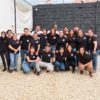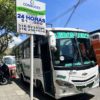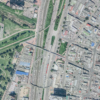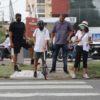One way to show the work done within the framework of the UN Habitat agreement was to ride the safe route on bicycle, explaining from the beginning the participation of private business (Plaza Mayor) and the differences that existed among the various entities in Medellin’s government.
For this, we called on different members of UN Habitat as well as other entities so they could see the route firsthand. This tour relied on the participation and collaboration of the Área Metropolitana del Valle de Aburrá; some of their bicycles were used and they rented 15 additional bicycles with the Siclas collective.
The main goal of the Safe Route experiential tour was to present the route in a formal way to the WUF attendees, including officials from UN Habitat and ITDP, among others. We presented and explained to them the development of the project from the installation of bike parking in the Plaza Mayor to the different stages of the Route’s implementation; convening the community, painting the bike lane, painting the flowerpots and bollards, seeding the plants, among others. At the end of the tour, the attendees were grateful for the tour and for Medellin’s initiative to provide such spaces for cyclists.
The experiential ride was relevant for 4 reasons:
– As a practical component, the tour was used to allow cyclists to get to know the Safe Route and have the opportunity to give their opinions on their experiences using it.
– We sought international support and recognition for the Safe Route, so this was a great opportunity to have people with experiences in different parts of the world to get to know the Route and give their opinions on its implementation. Local initiatives normally depend on feedback from people from their city, but in this case we had the timely participation of experts in non-motorized transport from other places in Latin America, Europe, and the United States.
– We presented non-motorized transport as a crucial component of a general transport policy and discussed the seriousness with which government agencies (AMVA and other involved parties) carried out the initiative. The fact that a global event had a specific non-motorized transport component integrating topics of equity and sustainability was fundamental to link with the theme of the WUF.
– The experiential tour was used as an opportunity to conceptually link non-motorized transport (as an example of low-tech, low-cost policy) with electric transport (as an example of high tech, high-tech, high-cost policy) as part of a mobility solutions package. This was accomplished through the integration of the tour with an event on electric mobility at the WUF.








Comentarios recientes